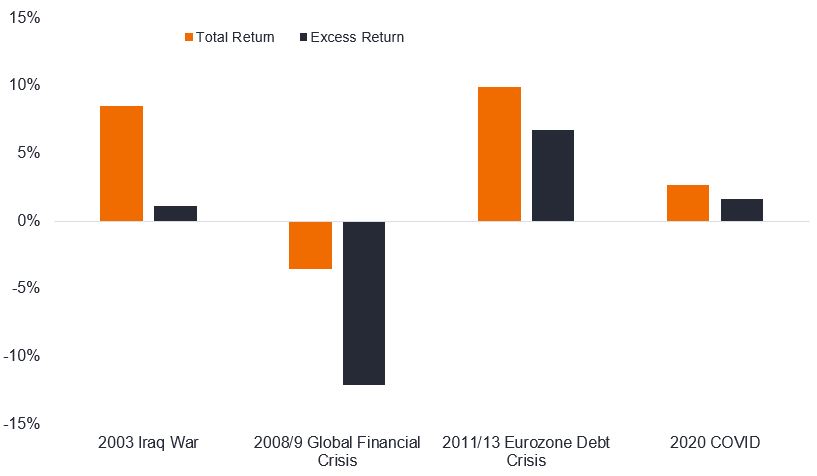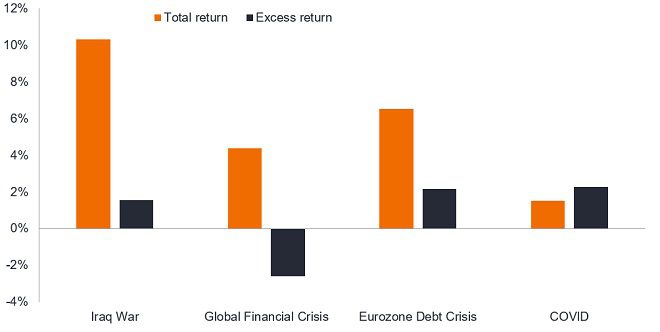Soft or hard landing: does it matter for investment grade bonds?
Portfolio Managers James Briggs and Tim Winstone look back at previous Eurozone economic downturns for their impact on investment grade corporate bonds and whether parallels exist with today.

7 minute read
Key takeaways:
- There have been four economic contractions in the Eurozone since 2000, with investment grade corporate bonds outperforming sovereign bonds in three of the four episodes.
- Extending the holding period around the downturn (to account for lack of precision when contractions start and end) typically smooths extremes in excess return and turns total return positive in all four periods.
- Looking at starting characteristics of past downturns, today’s investment grade corporate bond market has some commonalities with a deep economic downturn despite being priced more for a shallow downturn, in our view, warranting some caution.
Soft or hard? That’s the dilemma facing markets and we’re not talking about cheese. Can central banks engineer a soft landing for the economy or will they provoke a hard landing with a deep recession? We take a look at previous economic downturns in the Eurozone and whether there might be lessons for today’s euro investment grade (IG) corporate bond market.
During the last 25 years the Eurozone has had four contraction/recessionary episodes, as represented by periods of negative quarterly real gross domestic product (GDP) growth. The automatic assumption might be that holding government bonds over corporate bonds would be a good strategy in a period of economic weakness. History suggests that is only true in hard landings.
The four eurozone economic contractions are:
- 2003 Iraq War (Q1 2003 short contraction)
- 2008/9 Global Financial Crisis (Q2 2008 to Q1 2009 deep recession)
- 2011/13 Eurozone Debt Crisis (Q4 2011 to Q1 2013 protracted shallow recession)
- 2020 COVID Pandemic (Q1 2020 to Q4 2020 V-shaped recession)
The ICE BofA Euro Corporate Index is a basket of Euro investment grade corporate bonds. Returns data is available for both total return (combined income and capital movements) and excess returns. The excess return isolates the portion of performance that is attributed solely to credit and is equal to the corporate bond(s) total return minus the total return on a risk-matched basket of government bonds. It essentially displays the excess return on an index that comes from the additional yield that corporate bonds accrue over government bonds of the same maturity and the effect of any change in credit spreads over the period.
Figure 1 shows that in three out of the four periods, holding investment grade corporate bonds was more rewarding than holding government bonds. Incidentally, investment grade bonds also outperformed equities (as represented by the MSCI Europe ex UK Total Return Index) in three out of the four periods (the exception being the 2011-13 debt crisis).1
Figure 1: Total and excess returns of Euro investment grade corporate bonds during economic contractions (annualised figures)

Source: Janus Henderson, Bloomberg, ICE BofA Euro Corporate Index, total returns and excess returns in euro. All economic contraction periods are inclusive (Iraq War = Q1 2003, Global Financial Crisis = Q2 2008 to Q1 2009, Eurozone debt crisis = Q4 2011 to Q1 2013, COVID = Q1 2020 to Q4 2020). Annualised figures convert the cumulative return for a period into an an annual rate. Past performance does not predict future returns.
To correct for the fact that recessions do not just start and finish at the same time for all companies, i.e. some corporates will be affected earlier or later by economic weakness, in Figure 2 we expanded the period around the contractions to cover the preceding six months and the following six months. This turns total return positive in all the longer periods and tends to soften the extremes of excess return, i.e. lowers strong positive excess return and reduces negative excess return.
Figure 2: Total and excess returns of Euro investment grade corporate bonds during economic contractions plus six months either side (annualised figures)

Source: Source: Janus Henderson, Bloomberg, ICE BofA Euro Corporate Index, total returns and excess returns in euro. Periods in bold in brackets reflect the period shown, which comprises the six months before the contraction, the contraction period itself plus the six months after the contraction, all periods are inclusive. Iraq War = Q1 2003 (Q3 2002 to Q3 2003), Global Financial Crisis = Q2 2008 to Q1 2009 (Q4 2007 to Q3 2009), Eurozone debt crisis = Q4 2011 to Q1 2013 (Q2 2011 to Q3 2013), COVID = Q1 2020 to Q4 2020 (Q3 2019 to Q2 2021). Past performance does not predict future returns.
Given the uncertainty in the market about whether we will experience a hard or soft landing, the previous episodes are instructive. They reveal that it has historically made more sense to own investment grade corporate bonds over government bonds in all but the most severe economic contractions.
Accounting for differences
Of course, each of the four contractionary periods was different. But that can be helpful. We can look for similarities and differences among past contractions compared with today. In the table below we have colour coded green where factors are similar to today.
Figure 3: Eurozone economic and Euro Investment Grade (IG) factors at start of contraction
| Factor at start of contraction | 2003 Iraq War | 2008 Global Financial Crisis | 2011 Debt Crisis | 2020 COVID | 28 February 2023 |
|---|---|---|---|---|---|
| Extent of GDP contraction during downturn | -0.3% | -5.7% | -1.8% | -4.1% | ? |
| Inflation rate | 2.3% | 3.6% | 3.0% | 1.3% | 8.5% (Jan ’23) |
| Inflation falling or rising | Flat | Rising | Rising | Rising | Falling |
| ECB policy rate (refinance) | 2.75% | 4.0% | 1.5% | 0.0% | 3.0% |
| ECB policy rate falling or rising trend | Falling | Rising | Rising | Flat | Rising |
| Effective duration | 4.24 | 4.47 | 3.91 | 5.22 | 4.64 |
| Yield to worst on Euro IG | 4.41% | 5.63% | 4.06% | 0.51% | 4.32% |
| Yields falling or rising | Falling | Rising | Rising | Rising | Rising |
| Credit spread on Euro IG (basis points) | 96 | 179 | 299 | 94 | 147 |
| Unemployment rate | 9.0% | 7.4% | 10.5% | 7.5% | 6.6% (Dec ’22) |
| PMI manufacturing | 48.4 | 52 | 48.5 | 46.3 | 48.5 |
| Price (% of par weight on Euro IG) | 104 | 95 | 100 | 106 | 89 |
Source: Janus Henderson, Bloomberg: Eurozone real GDP at 2010 prices, inflation = Eurozone Harmonised Index of Consumer Prices, year on year % change, European Central Bank (ECB) policy refinancing rate, Eurostat Eurozone unemployment rate, Eurozone Manufacturing Purchasing Manager Index (a figure below 50 indicates contraction); ICE BofA Euro Corporate Index: yield to worst, credit spread = Govt option-adjusted spread (OAS), basis point (bp) equals 1/100 of a percentage point. 1 bp = 0.01%, 100 bps = 1%, effective duration, par weight price (price of a bond as a % of its face value, showing weighted average for the index). Figures in columns consecutively dated as at 31/12/2002, 31/03/2008, 30/09/2011, 31/12/2019 and 28/02/2023 (or latest figure available). Past performance does not predict future returns.
At first glance it looks disparate, but we should expect that as today’s environment is not a perfect match with any of the past contractions. If it were, investing might be a lot easier. The clearest distinction is inflation. In all previous episodes it was either flat or rising. Today it has rolled over and is coming down from a peak but the recent peak was much higher than at the start of previous economic downturns. How quickly it subsides will affect central bank policymaking so it remains a key variable for interest rate risk.
The colour coding in the table ominously has the most commonalities with the 2008 Global Financial Crisis (GFC) recession. Recall this was the downturn that resulted in negative excess return. Today’s yield and spread are below the levels at the start of 2008, which marries with our view that today’s market warrants some caution as it is not pricing in a severe recession. Despite the geopolitical risks emanating from Russia/Ukraine, however, we do not see the same systemic risk within the financial system that existed within the banking sector pre-GFC. Today, the banking sector is better capitalised and the coming downturn in our view is a more traditional economic downturn focused on consumer/corporate retrenchment, which ought to be less severe than a financial crisis.
Today’s yields and spreads are similar or higher than shallow recessions, potentially justifying current market pricing if the economy achieves a soft landing or shallow contraction. Another notable difference is that prices today are well below par values, creating a helpful pull to par. Judging against these parameters, Euro investment grade corporate bonds may be fairly priced for a shallow downturn and potentially offer value if the economy could avoid a recession altogether. Much will rest on how quickly inflation can recede and the response of central banks.
1Source: Janus Henderson, Bloomberg, MSCI Europe ex UK, ICE BofA Euro Corporate Index, total returns in USD. Periods as per Figure 1. Past performance does not predict future returns.
Credit spread: The difference in yield between securities with similar maturity but different credit quality. Widening spreads generally indicate deteriorating creditworthiness of corporate borrowers, and narrowing indicate improving.
Effective duration: The percentage change in the price of a bond given a parallel shift in the government bond yield curve. For an index, it is the average of its constituent security effective durations, weighted by full market value. For example, an effective duration of 5 means a rise in yield of 100 basis points or 1% would be expected to cause a fall in the bond price of 5%, and vice versa.
ICE BofA Euro Corporate Index: A measure of Euro denominated investment grade corporate debt publicly issued in the euro domestic or Eurobond markets.
Inflation: The annual rate of change in prices, typically expressed as a percentage rate. The Consumer Price Index (CPI) is a measure of the average change over time in the prices paid by urban consumers for a market basket of consumer goods and services.
Interest rate risk: The risk to bond prices caused by changes in interest rates. Bond prices move in the opposite direction to their yields, so a rise in rates and yields causes bond prices to fall and vice versa.
Investment grade: A bond typically issued by governments or companies perceived to have a relatively low risk of defaulting on their payments. The higher quality of these bonds is reflected in their higher credit ratings.
Monetary policy: The policies of a central bank, aimed at influencing the level of inflation and growth in an economy. It includes controlling interest rates and the supply of money.
Par value: The face value of the security, the amount that will be paid back on maturity.
Recession: A significant decline in economic activity lasting longer than a few months. A soft landing is a slowdown in economic growth that avoids a recession or the recession is shallow. A hard landing is a deep recession.
Volatility: The rate and extent at which the price of a portfolio, security or index moves up and down. If the price swings up and down with large movements, it has high volatility. If the price moves more slowly and to a lesser extent, it has lower volatility. The higher the volatility means the higher the risk of the investment.
Yield: The level of income on a security or index, typically expressed as a percentage rate.
Yield to worst (YTW) is the lowest yield a bond can achieve provided the issuer does not default and accounts for any applicable call feature (i.e. the issuer can call the bond back at a date specified in advance). At an index or portfolio level, this statistic represents the weighted average YTW for all the underlying issues.
These are the views of the author at the time of publication and may differ from the views of other individuals/teams at Janus Henderson Investors. References made to individual securities do not constitute a recommendation to buy, sell or hold any security, investment strategy or market sector, and should not be assumed to be profitable. Janus Henderson Investors, its affiliated advisor, or its employees, may have a position in the securities mentioned.
Past performance does not predict future returns. The value of an investment and the income from it can fall as well as rise and you may not get back the amount originally invested.
The information in this article does not qualify as an investment recommendation.
Marketing Communication.
Important information
Please read the following important information regarding funds related to this article.
- An issuer of a bond (or money market instrument) may become unable or unwilling to pay interest or repay capital to the Fund. If this happens or the market perceives this may happen, the value of the bond will fall.
- When interest rates rise (or fall), the prices of different securities will be affected differently. In particular, bond values generally fall when interest rates rise (or are expected to rise). This risk is typically greater the longer the maturity of a bond investment.
- The Fund invests in high yield (non-investment grade) bonds and while these generally offer higher rates of interest than investment grade bonds, they are more speculative and more sensitive to adverse changes in market conditions.
- Some bonds (callable bonds) allow their issuers the right to repay capital early or to extend the maturity. Issuers may exercise these rights when favourable to them and as a result the value of the Fund may be impacted.
- If a Fund has a high exposure to a particular country or geographical region it carries a higher level of risk than a Fund which is more broadly diversified.
- The Fund may use derivatives to help achieve its investment objective. This can result in leverage (higher levels of debt), which can magnify an investment outcome. Gains or losses to the Fund may therefore be greater than the cost of the derivative. Derivatives also introduce other risks, in particular, that a derivative counterparty may not meet its contractual obligations.
- If the Fund holds assets in currencies other than the base currency of the Fund, or you invest in a share/unit class of a different currency to the Fund (unless hedged, i.e. mitigated by taking an offsetting position in a related security), the value of your investment may be impacted by changes in exchange rates.
- When the Fund, or a share/unit class, seeks to mitigate exchange rate movements of a currency relative to the base currency (hedge), the hedging strategy itself may positively or negatively impact the value of the Fund due to differences in short-term interest rates between the currencies.
- Securities within the Fund could become hard to value or to sell at a desired time and price, especially in extreme market conditions when asset prices may be falling, increasing the risk of investment losses.
- Some or all of the ongoing charges may be taken from capital, which may erode capital or reduce potential for capital growth.
- CoCos can fall sharply in value if the financial strength of an issuer weakens and a predetermined trigger event causes the bonds to be converted into shares/units of the issuer or to be partly or wholly written off.
- The Fund could lose money if a counterparty with which the Fund trades becomes unwilling or unable to meet its obligations, or as a result of failure or delay in operational processes or the failure of a third party provider.
Specific risks
- An issuer of a bond (or money market instrument) may become unable or unwilling to pay interest or repay capital to the Fund. If this happens or the market perceives this may happen, the value of the bond will fall.
- When interest rates rise (or fall), the prices of different securities will be affected differently. In particular, bond values generally fall when interest rates rise (or are expected to rise). This risk is typically greater the longer the maturity of a bond investment.
- If a Fund has a high exposure to a particular country or geographical region it carries a higher level of risk than a Fund which is more broadly diversified.
- The Fund may use derivatives to help achieve its investment objective. This can result in leverage (higher levels of debt), which can magnify an investment outcome. Gains or losses to the Fund may therefore be greater than the cost of the derivative. Derivatives also introduce other risks, in particular, that a derivative counterparty may not meet its contractual obligations.
- If the Fund holds assets in currencies other than the base currency of the Fund, or you invest in a share/unit class of a different currency to the Fund (unless hedged, i.e. mitigated by taking an offsetting position in a related security), the value of your investment may be impacted by changes in exchange rates.
- When the Fund, or a share/unit class, seeks to mitigate exchange rate movements of a currency relative to the base currency (hedge), the hedging strategy itself may positively or negatively impact the value of the Fund due to differences in short-term interest rates between the currencies.
- Securities within the Fund could become hard to value or to sell at a desired time and price, especially in extreme market conditions when asset prices may be falling, increasing the risk of investment losses.
- Some or all of the ongoing charges may be taken from capital, which may erode capital or reduce potential for capital growth.
- The Fund could lose money if a counterparty with which the Fund trades becomes unwilling or unable to meet its obligations, or as a result of failure or delay in operational processes or the failure of a third party provider.

